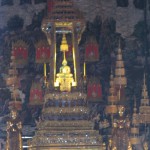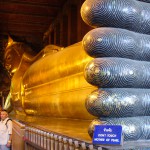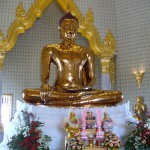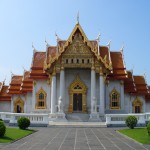The Wats
Our first day in Bangkok was a pretty typical tourist one, visiting the big big sites of the most impressive temples and images of Buddha within Bangkok, as well as the Grand Palace of the current line of Rama kings. The palace has been their home for several centuries including the current king Rama 9. Thailand is a constitutional monarchy like England, where the royals are revered throughout the country, but with much less personal failing. The Thai word for temple is “wat”.
The Buddha statues are a form of devotion by the givers and a type of instruction for those who visit and pray or meditate before them. Not surprisingly the most splendid are those commissioned or installed by the monarchs.

The Buddhas we saw ranged in size from the diminutive jade Emerald Buddha to the ginormous reclining Buddha. The little one sits only about 2 ½ feet tall, but is considered among the holiest of all Thai Buddhas, so not surprisingly it’s at the king’s temple. Buddha floats in a golden beam of light at the far end of the temple hall atop a huge gold altar, and is literally dressed up like a doll in three different styles depending on the season. Behind it sails a resplendent gold boat offering passage to a redemptive life.

The reclining Buddha, by contrast, is about 50 yards long, a mass of gold leaf over cement and brick, smiling benignly with a mouth about 6 yards wide.
Rounding out the notable statues at other wats we visited were additional imposing images. At Wat Traimit sits the world’s largest solid gold

Buddha, a graceful 13th century figure that weighs over 5 tons perched on a marzipan altar. At the Carrara marble temple built by the europhile king Rama 5, sits a sinuous copy of an original in Phitsanulok because it was considered one of the most beautiful of such images.

And we saw the four key types of Buddhas: the sitting, standing, reclining and walking representations.
Though the Buddhas are the central focus of a visit, some of the temple complexes that house them are spectacularly beautiful themselves, befitting the attempt by different kings – like royalty the world over – to demonstrate their piety and memorialize

their leadership. Especially at the Grand Palace, the buildings and chedis (or monuments to contain the ashes of the dead) are quite ornate, leaved with gold or brightly colored with glass and ceramics.
The Wais
We also learned much about the culture of Thais, including their religious practices and customs, as well as the stories of Buddha. And we tried to acknowledge their other customs. The “wai” (pronounced like why) is a way of acknowledging someone in greeting. You put your hands together somewhat as if you were praying and touch the hands somewhere between your temple and heart depending on a complicated system of respect.

Even Ronald McDonald offers a wai at the entrance of his restaurants.
It’s amazing how our use of the wai can engender such good cheer in a Thai native, just for our trying. Equally, the few Thai phrases we can figure out how to say receive a surprised, but grateful acknowledgment. Nancy said thank you at the end of a tour (khop khun ka) and got a broad smile of thank you in return from our English speaking guide.
Of course, we showed respect in the temples as well. We remove our shoes and sit on the floor, never pointing feet at the Buddha, and remain quiet on behalf of the people who come to these places to pray.
Barry didn’t quite realize that everyone had stopped moving at the train station later while the national anthem or the Thai God Save the King played over the loudspeakers, but expectations happily are low for foreigners.
The Wheres
The way to know a city is to keep an eye on the map, even if you’re being driven about, so you get oriented. But then you really learn when you start walking it or using the public transport.
That’s how our day ended up…Successfully, as we walked some main streets past the more famous of the night markets, and as we figured out how to use and pay for the sky train, a sleek rail line swooping two or three stories high above the city. And less successfully, as we tried to find a restaurant near our apartment, but were baffled for quite a while by the city’s system of obscure numbered alleys running off the main streets.
But that’s how you learn the essence of any city, jumping in and fumbling around.
(For more pictures in a slide show, go to our Thailand itinerary page.)

